Negrito
The Negrito (/nɪˈɡriːtoʊ/) are several diverse ethnic groups who inhabit isolated parts of Southeast Asia and the Andaman Islands. Their current populations include: the Andamanese peoples of the Andaman Islands, the Semang and Batek peoples of Peninsular Malaysia, the Maniq people of Southern Thailand, as well as the Aeta, Ati, and about 30 other officially recognized ethnic groups in the Philippines.
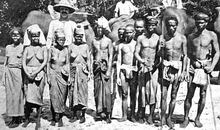 | |
| Regions with significant populations | |
|---|---|
(Andaman and Nicobar Islands) (Peninsular Malaysia) (Luzon, Palawan, Panay, Negros, and Mindanao) (Southern Thailand) | |
| Languages | |
| Andamanese languages, Aslian languages, Nicobarese languages, Philippine Negrito languages | |
| Religion | |
| Animism, folk religions |
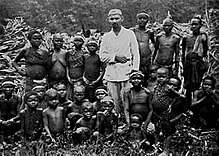
Based on their physical similarities, Negritos were once considered a single population of related people. Some studies suggest that they include several separate groups, as well as demonstrating that they are not closely related to the Pygmies of Africa, while more recent studies find evidence for a close genetic relation between the various Negrito groups.[1][2] The pre-Neolithic Negrito populations of Southeast Asia were largely replaced by the expansion of Southern East Eurasian populations, beginning about 5,000 years ago.[3]
Historically they engaged in trade with the local population that eventually invaded their lands and were also often subjected to slave raids while also paying tributes to the local Southeast Asian rulers and kingdoms. Some Negrito pygmies from the southern forests were enslaved and exploited from AD 724 until modern times.[4] While some have lived in isolation others have become assimilated with the general local population.
Etymology
The word Negrito is the Spanish diminutive of negro, used to mean "little black person". This usage was coined by 16th-century Spanish missionaries operating in the Philippines, and was borrowed by other European travellers and colonialists across Austronesia to label various peoples perceived as sharing relatively small physical stature and dark skin.[5] Contemporary usage of an alternative Spanish epithet, Negrillos, also tended to bundle these peoples with the pygmy peoples of Central Africa, based on perceived similarities in stature and complexion.[5] (Historically, the label Negrito has also been used to refer to African pygmies.)[6] The appropriateness of using the label "Negrito" to bundle peoples of different ethnicities based on similarities in stature and complexion has been challenged.[5]
.jpg)
Many online dictionaries give the plural in English as either "Negritos" or "Negritoes", without preference. The plural in Spanish is "Negritos".[7][8]
Culture
Most Negrito groups lived as hunter-gatherers, while some also used agriculture. Today most Negrito tribes live assimilated to the majority population of their homeland. Discrimination and poverty are often problems.[9]
Origins
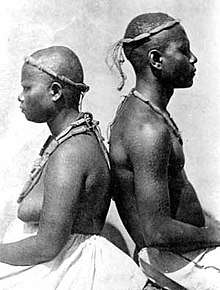

Genetics
Haplogroups
.jpg)
The main paternal haplogroup of the Negritos is K2b in the form of its rare primary clades K2b1* and P* (a.k.a. K2b2* or P-P295*). Most Aeta males (60%) carry K-P397 (K2b1), which is otherwise uncommon in the Philippines and is strongly associated with the indigenous peoples of Melanesia and Micronesia. Basal P* is rare outside the Aeta and some other groups within Maritime Southeast Asia.[10]
Some Negrito populations are Haplogroup D-M174*, a branch of D-M174 among Andaman Islanders, as well as Haplogroup O-P31 which is also common among the now Austroasiatic-speaking Negrito peoples, such as the Maniq and the Semang in Malaysia.[11] The Onge and all the Adamanan Islanders belong strictly to the mitochondrial Haplogroup M it is also the predominant marker of other Negrito tribes as well as Aboriginal Australians and Papuans.[12] Analysis of mtDNA, which is inherited exclusively by maternal descent, confirms the above results. All Onge belong to mDNA M, which is unique to Onge people.[13][14]
A 2009 study by the Anthropological Survey of India and the Texas Biomedical Research Institute identified seven genomes from 26 isolated "relic tribes" from the Indian mainland, such as the Baiga tribe, which share "two synonymous polymorphisms with the M42 haplogroup, which is specific to Australian Aborigines". These were specific mtDNA mutations that are shared exclusively by Australian aborigines and these Indian tribes, and no other known human groupings.[15]
Bulbeck (2013) shows the Andamanese maternal mtDNA is entirely mitochondrial Haplogroup M .[16] Their Y-DNA belongs to the D haplogroup, which has only been found in Japan and Tibet at low frequencies outside of the Andaman Islands, a fact that underscores the insularity of these tribes.[12]
Origin and ethnic relations
A study of human blood group systems and proteins in the 1950s suggested that the Andamanese peoples were more closely related to Oceanic peoples than African pygmy peoples. Genetic studies on Philippine Negritos, based on polymorphic blood enzymes and antigens, showed that they were similar to their surrounding populations.[17]
Negrito peoples may descend from the first settlers of South and Southeast Asia. Despite being isolated, the different peoples do share genetic similarities with their neighboring populations.[17][18] They also show relevant phenotypic (anatomic) variations which require explanation.[18]
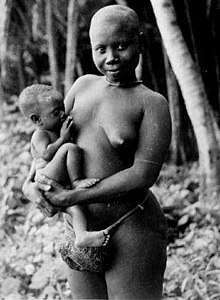
This has often been interpreted to the effect that they are remnants of the original expansion from Africa some 70,000 years ago. Studies in osteology, cranial shape and dental morphology have connected the Semang to Australoid populations, while connecting the Andamanese to Africans in craniometry and to South Asians in dental morphology, and Philippine Negritos to Southeast Asians. A possible conclusion of this is that the dispersal of mitochondrial haplogroup B4a1a is connected to the distinction between Philippine and other Negritos.[16] However, another study suggests that the Onge (indigenous to Little Andaman) are more closely related to Southeast Asian Negritos, Melanesians, and Southeast Asians than they are to present-day South Asians, and that the Great Andamanese (of the northern Andamans, as opposed to the Onge or other Andamanese groups) "appear to have received a degree of relatively recent admixture from adjacent regional populations but also share a significant degree of genetic ancestry with Malaysian negrito groups".[19]
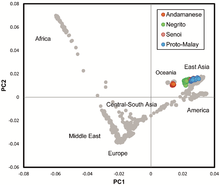
A recent genetic study found that unlike other early groups in Oceania, Andamanese Negritos lack Denisovan hominin admixture in their DNA. Denisovan ancestry is found among indigenous Melanesian and Aboriginal Australian populations at between 4–6%.[20][21]
Some studies have suggested that each group should be considered separately, as the genetic evidence refutes the notion of a specific shared ancestry between the "Negrito" groups of the Andaman Islands, the Malay Peninsula, and the Philippines.[22] Indeed, this sentiment is echoed in a more recent work from 2013 which concludes that "at the current level of genetic resolution ... there is no evidence of a single ancestral population for the different groups traditionally defined as 'negritos'.[19]
Recent studies, concerning the population history of Southeast Asia, suggest that most modern Negrito populations in Southeast Asia show a rather strong Eastern Eurasian admixture (Austronesian and Austroasiatic), ranging between 30% to 50% of their ancestry.[23]
Chaubey et al. 2013 notes that the Andamanese people are closely related to other Negrito populations as well as Melanesians.[24]
According to Basu et al. (2016), Andamanese and other Negrito populations are closely related and share also partial relation to Indigenous people of New Guinea.[1]
Narasimhan et al. 2018 observe that samples from the Indus Valley Civilisation population in northern India are always mixes of the same two proximal sources of AASI (ancient ancestral south Indian: Andamanese-related hunter gatherers) and Iranian agriculturalist-related ancestry; with "one of the Indus Periphery individuals having ~42% AASI ancestry. According Narasimhan the genetic makeup of the ASI (Ancestral South Indian) population consisted of about 73% AASI/Andamanese-related and about 27% Iranian-related ancestry.[25]
In 2019, Narasimhan shows that the ASI (Ancestral South Indians) are descendants of the AASI with following admixture from Iranian-related agriculturalists. He further notes that the high correlation between Dravidian and ASI ancestry may suggest that the Dravidians (and the proto-Dravidian language) originated from the AASI component and is native to the peninsula of India.[26]
Physical anthropology
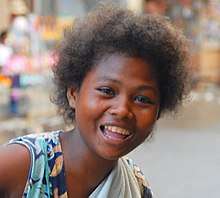
A number of features would seem to suggest a common origin for the Negrito and Pygmy peoples, including short stature, dark skin, scant body hair, and occasional steatopygia (large, curvaceous buttocks and thighs). The claim that the Andamanese more closely resemble African pygmies than other Austronesian populations in their cranial morphology in a study of 1973 added some weight to this theory, before genetic studies pointed to a closer relationship with their neighbours.[17]
Multiple studies also show that Negritos share a closer cranial affinity with Aboriginal Australians and Melanesians.[27][28]
Notes

References
- Basu, Analabha; Sarkar-Roy, Neeta; Majumder, Partha P. (9 February 2016). "Genomic reconstruction of the history of extant populations of India reveals five distinct ancestral components and a complex structure". Proceedings of the National Academy of Sciences of the United States of America. 113 (6): 1594–1599. doi:10.1073/pnas.1513197113. ISSN 0027-8424. PMC 4760789. PMID 26811443.
- Chaubey, Gyaneshwer; Endicott, Phillip (27 November 2013). "The Andaman Islanders in a Regional Genetic Context: Reexamining the Evidence for an Early Peopling of the Archipelago from South Asia". Human Biology. 85 (1): 153–72. doi:10.3378/027.085.0307. ISSN 0018-7143. PMID 24297224.
- S. Noerwidi, "Using Dental Metrical Analysis to Determine the Terminal Pleistocene and Holocene Population History of Java", in: Philip J. Piper, Hirofumi Matsumura, David Bulbeck (eds.), New Perspectives in Southeast Asian and Pacific Prehistory (2017), p. 92.
- Archives of the Chinese Art Society of America
- Manickham, Sandra Khor (2009). "Africans in Asia: The Discourse of 'Negritos' in Early Nineteenth-century Southeast Asia". In Hägerdal, Hans (ed.). Responding to the West: Essays on Colonial Domination and Asian Agency. Amsterdam University Press. pp. 69–79. ISBN 978-90-8964-093-2.
- See, for example: Encyclopædia Britannica Eleventh Edition, 1910–1911: "Second are the large Negrito family, represented in Africa by the dwarf-races of the equatorial forests, the Akkas, Batwas, Wochuas and others..." (p. 851)
- "Definition of NEGRITO". www.merriam-webster.com.
- "Negrito" – via The Free Dictionary.
- "The succesful [sic] revival of Negrito culture in the Philippines". Rutu Foundation. 6 May 2015. Retrieved 19 July 2019.
- ISOGG, 2016, Y-DNA Haplogroup P and its Subclades – 2016 (20 June 2016).
- Craniodental Affinities of Southeast Asia's "Negritos" and the Concordance with Their Genetic Affinities by David Bulbeck 2013
- Kumarasamy Thangaraj, Lalji Singh, Alla G. Reddy, V. Raghavendra Rao, Subhash C. Sehgal, Peter A. Underhill, Melanie Pierson, Ian G. Frame, and Erika Hagelberg (2002), Genetic Affinities of the Andaman Islanders, a Vanishing Human Population (PDF), archived from the original (PDF) on 29 October 2008, retrieved 16 November 2008CS1 maint: multiple names: authors list (link)
- M. Phillip Endicott; Thomas P. Gilbert; Chris Stringer; Carles Lalueza-Fox; Eske Willerslev; Anders J. Hansen; Alan Cooper (2003), "The Genetic Origins of the Andaman Islanders" (PDF), American Journal of Human Genetics, 72 (1): 178–184, doi:10.1086/345487, PMC 378623, PMID 12478481, retrieved 21 April 2009
- Reich, David; Kumarasamy Thangaraj; Nick Patterson; Alkes L. Price; Lalji Singh (24 September 2009). "Reconstructing Indian Population History". Nature. 461 (7263): 489–494. doi:10.1038/nature08365. PMC 2842210. PMID 19779445.
- Satish Kumar; Rajasekhara Reddy Ravuri; Padmaja Koneru; BP Urade; BN Sarkar; A Chandrasekar; VR Rao (22 July 2009), "Reconstructing Indian-Australian phylogenetic link", BMC Evolutionary Biology, 9: 173, doi:10.1186/1471-2148-9-173, PMC 2720955, PMID 19624810,
In our completely sequenced 966-mitochondrial genomes from 26 relic tribes of India, we have identified seven genomes, which share two synonymous polymorphisms with the M42 haplogroup, which is specific to Australian Aborigines ... direct genetic evidence of an early colonization of Australia through south Asia
- Bulbeck, David (November 2013). "Craniodental Affinities of Southeast Asia's "Negritos" and the Concordance with Their Genetic Affinities". Human Biology. 85 (1): 95–134. doi:10.3378/027.085.0305. PMID 24297222. Retrieved 17 December 2013.
- Thangaraj, Kumarasamy; et al. (21 January 2003), "Genetic Affinities of the Andaman Islanders, a Vanishing Human Population" (PDF), Current Biology, 13 (2): 86–93, doi:10.1016/S0960-9822(02)01336-2, PMID 12546781, archived from the original (PDF) on 29 October 2008
- Stock, JT (2013). "The skeletal phenotype of "negritos" from the Andaman Islands and Philippines relative to global variation among hunter-gatherers". Human Biology. 85 (1–3): 67–94. doi:10.3378/027.085.0304. PMID 24297221.
- Chaubey, Gyaneshwer; Endicott, Phillip (1 February 2013). "The Andaman Islanders in a regional genetic context: reexamining the evidence for an early peopling of the archipelago from South Asia". Human Biology. 85 (1–3): 153–172. doi:10.3378/027.085.0307. ISSN 1534-6617. PMID 24297224.
- Reich; et al. (2011). "Denisova Admixture and the First Modern Human Dispersals into Southeast Asia and Oceania". The American Journal of Human Genetics. 89 (4): 516–528. doi:10.1016/j.ajhg.2011.09.005. PMC 3188841. PMID 21944045.
- "Oldest human DNA found in Spain – Elizabeth Landau's interview of Svante Paabo". CNN. 9 December 2013.
About 3% to 5% of the DNA of people from Melanesia (islands in the southwest Pacific Ocean), Australia and New Guinea as well as aboriginal people from the Philippines comes from the Denisovans.
- Catherine Hill; Pedro Soares; Maru Mormina; Vincent Macaulay; William Meehan; James Blackburn; Douglas Clarke; Joseph Maripa Raja; Patimah Ismail; David Bulbeck; Stephen Oppenheimer; Martin Richards (2006), "Phylogeography and Ethnogenesis of Aboriginal Southeast Asians" (PDF), Molecular Biology and Evolution, 23 (12): 2480–91, doi:10.1093/molbev/msl124, PMID 16982817, archived from the original (PDF) on 9 April 2008
- Reconstructing Austronesian population history in Island Southeast Asia - Lipson et al. (https://www.biorxiv.org/content/biorxiv/early/2014/05/27/005603.full.pdf)
- Chaubey, Gyaneshwer; Endicott, Phillip (2013). "The Andaman Islanders in a Regional Genetic Context: Reexamining the Evidence for an Early Peopling of the Archipelago from South Asia". Human Biology. 85 (1): 153–72. doi:10.3378/027.085.0307. ISSN 0018-7143. PMID 24297224.
- Narasimhan, Vagheesh M.; Patterson, Nick; Moorjani, Priya; Lazaridis, Iosif; Lipson, Mark; Mallick, Swapan; Rohland, Nadin; Bernardos, Rebecca; Kim, Alexander M.; Nakatsuka, Nathan; Olalde, Iñigo (31 March 2018). "The Genomic Formation of South and Central Asia". bioRxiv: 292581. doi:10.1101/292581.
- Narasimhan, Vagheesh M.; Patterson, Nick; Moorjani, Priya; Rohland, Nadin; Bernardos, Rebecca; Mallick, Swapan; Lazaridis, Iosif; Nakatsuka, Nathan; Olalde, Iñigo; Lipson, Mark; Kim, Alexander M. (6 September 2019). "The Formation of Human Populations in South and Central Asia". Science. 365 (6457): eaat7487. doi:10.1126/science.aat7487. ISSN 0036-8075. PMC 6822619. PMID 31488661.
- William Howells (1993). Getting Here: The Story of Human Evolution. Compass Press.
- David Bulbeck; Pathmanathan Raghavan; Daniel Rayner (2006), "Races of Homo sapiens: if not in the southwest Pacific, then nowhere", World Archaeology, 38 (1): 109–132, CiteSeerX 10.1.1.534.3176, doi:10.1080/00438240600564987, ISSN 0043-8243, JSTOR 40023598
Further reading
- Evans, Ivor Hugh Norman. The Negritos of Malaya. Cambridge [Eng.]: University Press, 1937.
- Benjamin, Geoffrey. 2013. ‘Why have the Peninsular “Negritos” remained distinct?’ Human Biology 85: 445–484. [ISSN 0018-7143 (print), 1534-6617 (online)]
- Garvan, John M., and Hermann Hochegger. The Negritos of the Philippines. Wiener Beitrage zur Kulturgeschichte und Linguistik, Bd. 14. Horn: F. Berger, 1964.
- Hurst Gallery. Art of the Negritos. Cambridge, Massachusetts: Hurst Gallery, 1987.
- Khadizan bin Abdullah, and Abdul Razak Yaacob. Pasir Lenggi, a Bateq Negrito Resettlement Area in Ulu Kelantan. Pulau Pinang: Social Anthropology Section, School of Comparative Social Sciences, Universití Sains Malaysia, 1974.
- Mirante, Edith (2014). The Wind in the Bamboo: Journeys in Search of Asia's 'Negrito' Indigenous Peoples. Bangkok, Orchid Press.
- Schebesta, P., & Schütze, F. (1970). The Negritos of Asia. Human relations area files, 1-2. New Haven, Conn: Human Relations Area Files.
- Armando Marques Guedes (1996). Egalitarian Rituals. Rites of the Atta hunter-gatherers of Kalinga-Apayao, Philippines, Social and Human Sciences Faculty, Universidade Nova de Lisboa.
- Zell, Reg. About the Negritos: A Bibliography. edition blurb, 2011.
- Zell, Reg. Negritos of the Philippines. The People of the Bamboo - Age - A Socio-Ecological Model. edition blurb, 2011.
- Zell, Reg, John M. Garvan. An Investigation: On the Negritos of Tayabas. edition blurb, 2011.
External links
| Wikimedia Commons has media related to Negrito. |
| Wikisource has the text of the 1879 American Cyclopædia article Negritos. |
- Negritos of Zambales—detailed book written by an American at the turn of the previous century holistically describing the Negrito culture
- Andaman.org: The Negrito of Thailand
- The Southeast Asian Negrito